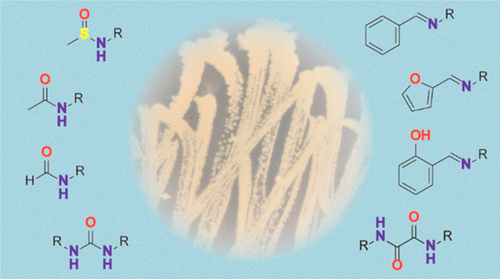当前位置:
X-MOL 学术
›
J. Nat. Prod.
›
论文详情
Our official English website, www.x-mol.net, welcomes your
feedback! (Note: you will need to create a separate account there.)
Nitrogen-Containing Volatiles from Marine Salinispora pacifica and Roseobacter-Group Bacteria
Journal of Natural Products ( IF 3.3 ) Pub Date : 2017-12-01 00:00:00 , DOI: 10.1021/acs.jnatprod.7b00789 Tim Harig 1 , Christian Schlawis 1 , Lisa Ziesche 1 , Marion Pohlner 2 , Bert Engelen 2 , Stefan Schulz 1
Journal of Natural Products ( IF 3.3 ) Pub Date : 2017-12-01 00:00:00 , DOI: 10.1021/acs.jnatprod.7b00789 Tim Harig 1 , Christian Schlawis 1 , Lisa Ziesche 1 , Marion Pohlner 2 , Bert Engelen 2 , Stefan Schulz 1
Affiliation

|
Bacteria can produce a wide variety of volatile compounds. Many of these volatiles carry oxygen, while nitrogen-containing volatiles are less frequently observed. We report here on the identification and synthesis of new nitrogen-containing volatiles from Salinispora pacifica CNS863 and explore the occurrence in another bacterial lineage, exemplified by Roseobacter-group bacteria. Several compound classes not reported before from bacteria were identified, such as dialkyl ureas and oxalamides. Sulfinamides have not been reported before as natural products. The actinomycete S. pacifica CNS863 produces, for example, sulfinamides N-isobutyl- and N-isopentylmethanesulfinamide (5, 6), urea N,N′-diisobutylurea (16), and oxalamide N,N′-diisobutyloxalamide (17). In addition, new imines such as (E)-1-(furan-2-yl)-N-(2-methylbutyl)methanimine (8) and (E)-2-((isobutylimino)methyl)phenol (13) were identified together with several other imines, acetamides, and formamides. Some of these compounds including the sulfinamides were also released by the Roseobacter-group bacteria Roseovarius pelophilus G5II, Pseudoruegeria sp. SK021, and Phaeobacter gallaeciensis BS107, although generally fewer compounds were detected. These nitrogen-containing volatiles seem to originate from biogenic amines derived from the amino acids valine, leucine, and isoleucine.
中文翻译:

海洋盐藻和迷迭香属细菌中的含氮挥发物
细菌可产生多种挥发性化合物。这些挥发性物质中很多都携带氧气,而含氮挥发性物质则较少见。我们在此报告了从盐藻CNS863鉴定和合成新的含氮挥发物的报告,并探讨了另一种细菌谱系中的发生,例如玫瑰杆菌属细菌。鉴定了以前从未从细菌中报告过的几种化合物类别,例如二烷基脲和草酰胺。以前从未报道过将亚磺酰胺作为天然产物。放线菌S.茵CNS863产生,例如,亚磺酰胺Ñ -异丁基-和Ñ -isopentylmethanesulfinamide(5,6),尿素Ñ,Ñ ' - diisobutylurea(16),和草酰胺Ñ,Ñ ' - diisobutyloxalamide(17)。另外,新的亚胺如(E)-1-(呋喃-2-基)-N-(2-甲基丁基)甲亚胺(8)和(E)-2-((异丁基亚氨基)甲基)苯酚(13)。与其他几种亚胺,乙酰胺和甲酰胺一起鉴定。这些化合物中的一些(包括亚磺酰胺)也被玫瑰细菌群细菌Roseovarius pelophilus G5II,假性伪狂犬病菌释放。sp。SK021和Phaeobacter gallaeciensis BS107,尽管通常检测到的化合物较少。这些含氮挥发物似乎源自氨基酸缬氨酸,亮氨酸和异亮氨酸的生物胺。
更新日期:2017-12-01
中文翻译:

海洋盐藻和迷迭香属细菌中的含氮挥发物
细菌可产生多种挥发性化合物。这些挥发性物质中很多都携带氧气,而含氮挥发性物质则较少见。我们在此报告了从盐藻CNS863鉴定和合成新的含氮挥发物的报告,并探讨了另一种细菌谱系中的发生,例如玫瑰杆菌属细菌。鉴定了以前从未从细菌中报告过的几种化合物类别,例如二烷基脲和草酰胺。以前从未报道过将亚磺酰胺作为天然产物。放线菌S.茵CNS863产生,例如,亚磺酰胺Ñ -异丁基-和Ñ -isopentylmethanesulfinamide(5,6),尿素Ñ,Ñ ' - diisobutylurea(16),和草酰胺Ñ,Ñ ' - diisobutyloxalamide(17)。另外,新的亚胺如(E)-1-(呋喃-2-基)-N-(2-甲基丁基)甲亚胺(8)和(E)-2-((异丁基亚氨基)甲基)苯酚(13)。与其他几种亚胺,乙酰胺和甲酰胺一起鉴定。这些化合物中的一些(包括亚磺酰胺)也被玫瑰细菌群细菌Roseovarius pelophilus G5II,假性伪狂犬病菌释放。sp。SK021和Phaeobacter gallaeciensis BS107,尽管通常检测到的化合物较少。这些含氮挥发物似乎源自氨基酸缬氨酸,亮氨酸和异亮氨酸的生物胺。











































 京公网安备 11010802027423号
京公网安备 11010802027423号